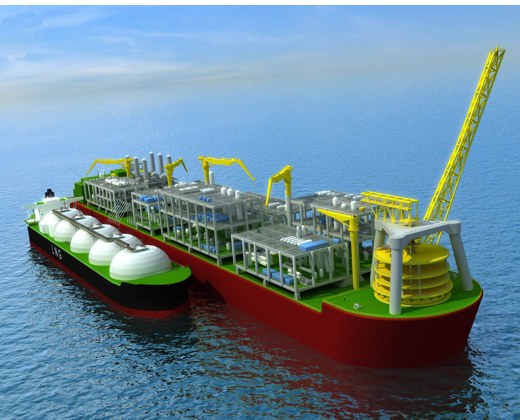Prelude FLNG, rendering via Shell
 By Ari Rabinovitch
By Ari Rabinovitch
JERUSALEM (Reuters) – The latest floating terminal technology could be the key to unlocking gas exports from Israel’s Tamar field and the larger related gas riches of the eastern Mediterranean.
Russian energy group Gazprom said on Tuesday it is in exclusive talks to buy liquefied natural gas (LNG) from Tamar, located about 90 km off Israel’s coast.
To do so, it plans to use a massive, floating LNG vessel (FLNG) that will receive, liquefy and then ship the gas on site.
If it works for Tamar, which has estimated reserves of 9.7 trillion cubic feet (tcf), a second could be brought to the nearby Leviathan field, which is more than twice the size and was the world’s largest offshore discovery of the past decade.
“We hope it will put us in a better position to help with Leviathan,” said Kathleen Eisbrenner, chief executive of Pangea LNG, the vessel’s developer, who helped develop the Gazprom deal.
Gazprom is the world’s biggest gas producer and relies heavily on pipeline supplies to Europe, which make up around 80 percent of its revenues. It is keen to expand in the LNG sector to grow in the booming Asian market.
Two of the main partners in Tamar, Texas-based Noble Energy and Israel’s Delek Energy, are also part of the consortium developing Leviathan.
The Tamar and Leviathan finds sparked an exploration frenzy in the area. The U.S. Geological Survey has said the eastern Mediterranean’s Levant basin could hold up to 122 tcf of recoverable gas, making it one of the world’s richest deposits.
The first FLNG facility is being built for Royal Dutch Shell , the world’s top LNG trading company, for use off the coast of Australia, where natural gas fields are being tapped for future export to Asia.
Shell’s Prelude FLNG project is expected to become operational by the end of the decade.
Prelude, which will be the world’s biggest offshore structure, is being built in South Korea by a joint-venture between France’s Technip and South Korea’s Samsung Heavy Industries.
Each floating LNG vessel costs $3 to $4 billion to construct, Eisbrenner told Reuters, adding that Tamar’s FLNG vessel would be the third to become operational.
Pangea LNG is partly owned by Daewoo.
Most of Tamar’s gas is earmarked for domestic use, and in the deal being discussed, Gazprom would export roughly a third of its reserves over a 20-year period, starting in 2017. The price for the LNG would be linked to the price of Brent.
Analysts say FLNG terminals will become a major growth market within the next years, as they offer more flexibility than stationary terminals.
“Capex will exceed $28.6 billion between 2012 and 2018,” energy consultants Douglas Westwood said.
“Floating regasification is proving popular in countries wishing to access the buoyant LNG market. The relative cost advantages over onshore terminals plus the short lead times are proving to be a substantial incentive for developers,” they added.
UNCERTAINTY REMAINS
Some uncertainty remains though, because Israel has yet to officially say it will allow significant gas exports.
Prime Minister Benjamin Netanyahu is still forming a government after last month’s election, and it could be weeks before a formal decision is made.
“The Tamar partners tell us they do not have concerns in this regard,” Eisbrenner said.
Gazprom will hold exclusive talks for six months with the aim of reaching a binding agreement with the marketing agent for the Tamar project. Russia is looking to diversify its gas exports, which are focused on the weak European market, and a deal could strengthen its hand in the booming Asian LNG market.
Where the gas from Tamar will be sold, Eisbrenner said, “That is for Gazprom to decide, but we target netbacks from Asia.” (Additional reporting by Henning Gloystein in London, editing by William Hardy and Anthony Barker)
(c) 2013 Thomson Reuters, Click For Restrictions

 Join The Club
Join The Club











